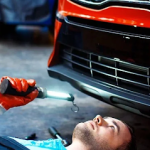Even the most ardent car enthusiasts will agree that the incessant noise and vibration generated by some of the older UK car models can often dampen the driving experience. While these vintage vehicles evoke a nostalgic charm, they often lack the high-tech soundproofing measures that modern cars possess. This article aims to provide you with a comprehensive guide on how to effectively reduce noise and vibration in your vintage vehicle, enhance your comfort during drives and improve your overall ride experience.
Understanding the source of noise and vibration in older cars
To effectively reduce noise and vibration, it’s crucial to understand their sources. In older vehicles, these nuisances often originate from the car’s engine, the treading of tires on the road, and air passing over the vehicle at high speeds. Additionally, the lack of modern soundproofing materials in vintage cars amplifies these disturbances.
Have you seen this : What are the precise legal steps for registering a custom-built car in the UK?
Engine noise is typically high-pitched, due to the explosive combustion process. The road noise, on the other hand, is generally a low-frequency hum produced by the tires’ contact with the road surface. The air noise is a whistling sound created by the airflow around the car. By understanding these sources, you can apply targeted strategies to mitigate them.
The importance of damping and deadening for soundproofing
Sound damping and deadening are two effective techniques for minimising noise and vibrations in vehicles. By implementing these, you can significantly enhance the acoustic comfort of your vintage car. Damping involves controlling the vibrational energy of materials by converting it into heat, thus reducing both noise and vibrations. Deadening, on the contrary, focuses on reducing the ability of a material to resonate, which, in turn, decreases the noise.
In parallel : Optimize your heavy-duty vehicle with air suspension solutions
You can apply these techniques to various areas of your vehicle, such as the door panels, floor, and boot. Using high-quality sound deadening mats is an excellent way to start. These mats reduce vibrations, thereby mitigating the noise produced.
The role of tyres and road condition
Tyres play a significant role in generating road noise. The friction between the tyres and the road surface is a primary source of low-frequency noise in cars. Therefore, choosing the best tyres for your vehicle can significantly reduce this noise. Consider investing in high-quality tyres with noise-reducing properties. They are designed to minimise vibration and help provide a quieter ride.
The condition of the road also plays a significant part in the level of noise and vibration in your vehicle. Rough, uneven roads will emit more noise than smooth, well-maintained ones. Therefore, when planning your drives, opt for well-paved roads to ensure a smoother and quieter ride.
Modifications to enhance air flow
Airflow around a car, particularly at high speeds, can create a substantial amount of noise. To reduce this, consider making modifications to your vehicle’s aerodynamics. Smoother lines and curves can help better manage airflow and limit the noise it generates.
You can make these modifications by adding a customised spoiler or adjusting the shape of your car’s mirrors. Additionally, sealing gaps where the wind might enter, such as around doors and windows, will also help reduce noise.
Utilising high-quality soundproofing materials
Investing in high-quality soundproofing materials for your vehicle can greatly reduce noise and vibration. Soundproofing materials work by absorbing or blocking sound waves, thereby reducing the overall noise level inside the vehicle.
There are several types of soundproofing materials available, such as mass-loaded vinyl, foam insulation, and soundproofing mats. Each of these materials has unique properties and uses. For instance, mass-loaded vinyl is an excellent sound blocker and is often used in areas where the noise level is exceptionally high. Foam insulation, however, is better suited for absorptive damping. Your choice of soundproofing materials will depend on the specific noise issues your vintage car possesses.
In conclusion, reducing noise and vibration in older UK cars is not an impossible task. By identifying the sources of these disturbances, applying appropriate damping and deadening techniques, choosing the right tyres, making modifications to enhance airflow, and using high-quality soundproofing materials, you can create a quieter and more comfortable driving experience in your vintage vehicle.
Sound Deadening and Suspension System Modifications
Sound deadening is a key strategy for noise reduction in older UK car models. As mentioned earlier, sound deadening involves reducing the ability of a material to resonate, which in turn decreases noise. This is typically achieved by adding a layer of special material, like mass-loaded vinyl or sound deadening mats, to the body of the car. This material absorbs the sound waves and vibrations, reducing the overall noise inside the vehicle.
Another strategy for noise reduction is to modify the suspension system of the car. The suspension system of a car is designed to provide a smooth ride and control the car’s handling and ride comfort. In older cars, the suspension system may be worn out, leading to increased noise and vibration. By replacing the worn-out parts of the suspension system, you can drastically reduce the noise and vibration in the car.
Replacing the brake pads can also help to reduce noise. Old, worn-out brake pads can produce a squeaking noise when the brakes are applied. High-quality brake pads, on the other hand, are made of materials that minimise noise and vibration.
For the best results, it is advisable to consult with a professional mechanic who specialises in vintage cars. They would have the necessary expertise to advice on the best sound deadening materials and suspension system modifications for your specific car model.
Insurance, Power Steering and Passenger Comfort
When it comes to older UK cars, there are a few more aspects that can be considered to effectively reduce noise and vibration. For one, a car’s power steering system can contribute to the overall noise levels. If your car’s power steering system is faulty or worn out, it can produce a whining noise. Regular servicing and maintenance of the power steering system can ensure it functions optimally and contributes to noise reduction.
Car insurance providers in the UK offer some coverage options that can help with noise and vibration reduction costs. Some insurance policies cover the cost of modifications made for the purpose of reducing noise and vibration. Therefore, it’s worth checking with your car insurance provider to see if they offer such a coverage. This can help reduce the overall cost of the noise and vibration reduction process.
Lastly, passenger comfort is a key aspect to consider. A quiet and comfortable ride can greatly enhance the overall driving experience. Vibration isolation technologies, such as anti-vibration mounts, can help to mitigate the effects of engine and road vibrations on the passengers. These technologies work by absorbing and dissipating the vibration energy, thereby enhancing ride comfort.
Conclusion
In summary, owning and maintaining an older UK car model doesn’t mean you have to put up with high noise and vibration levels. With a combination of sound deadening, modification of the suspension system and power steering maintenance, you can effectively reduce noise and enhance ride comfort. Additionally, insurance coverage options can aid in offsetting costs, making these modifications a viable and low-cost solution to the noise and vibration problem. By implementing these changes, you can significantly improve your driving experience and truly enjoy the charm of your vintage vehicle.












